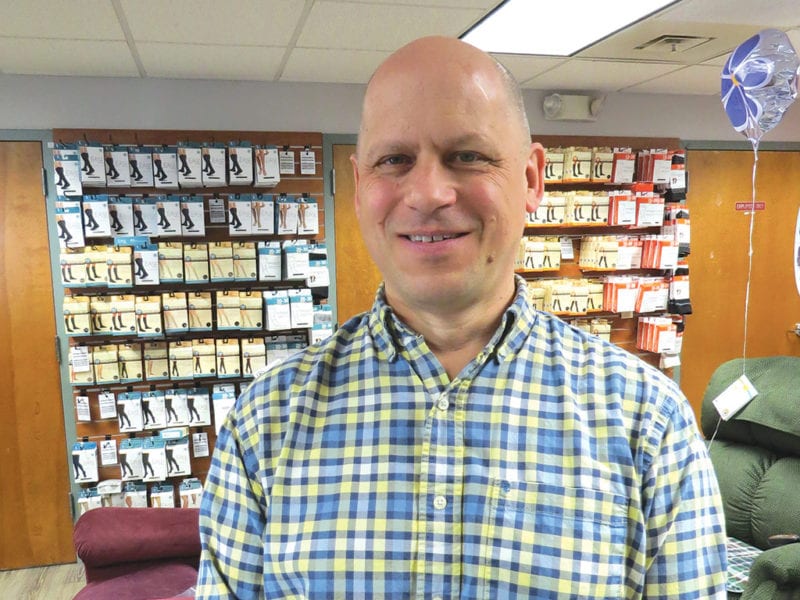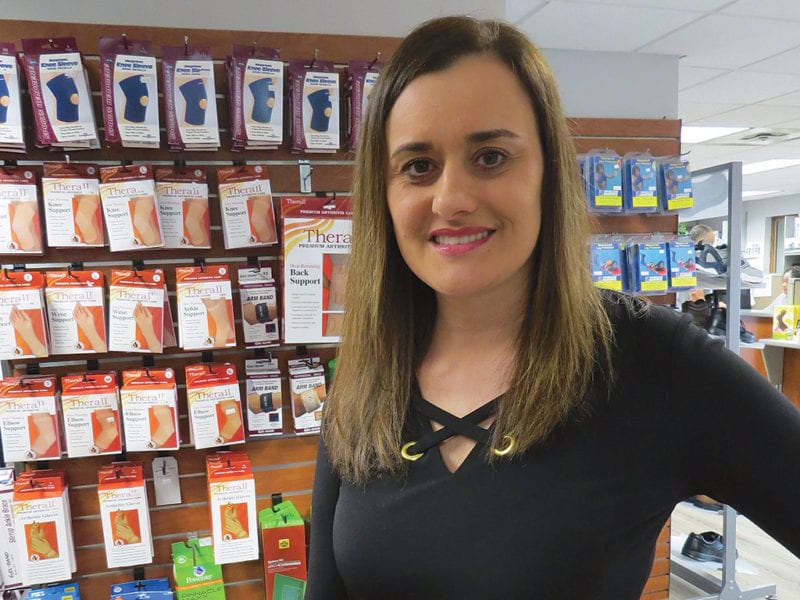Louis & Clark Continues a Long Tradition of Innovation
On the Path of Discovery
By George O’Brien
By now, a good number of people in this region know the story of how the second-generation, 55-year-old company known to most as Louis & Clark came to take that name.
The sign over the pharmacy on Memorial Drive in Chicopee in the mid-’60s read ‘Airline Drug,’ an obvious nod to what was then known as Westover Air Force Base, just a few hundred yards away. But before long, many customers had unofficially renamed it, using the first names of the partners — and pharmacists — who had acquired the business, Louis Demosthenous and Clark Matthews, who just happened to share names with those famous explorers (sort of).
“There weren’t really marketing companies back then,” Skip Matthews, Clark’s son, explained with a laugh. “It was just … we were Airline Drug, the customers started calling it Louis & Clark, and they kept calling it that, so they changed the name. I imagine that feeds your ego pretty well, too.”
Perhaps a less-known story (although the company is investing considerable time and energy in telling it, as we’ll see later) is how this company continues to evolve and respond to change — within the industry, in societal needs, in demographics, and even in the way companies are operated.

We’ll start with the much longer name over the door. Under the ‘Louis & Clark’ in large type (with a stick figure in a wheelchair taking the place of a traditional ampersand) are the words ‘Pharmacy & Home Medical Supplies,’ and they go a long way toward telling this story.
Indeed, a company that once had several pharmacies scattered across this region has seen that division of the company remain vibrant while also taking on a different look and feel. There are fewer locations — in fact, just one — but also a greater focus on convenience and delivery.
It’s all on display at the company’s recently opened pharmacy on Brookdale Drive in Springfield.
Formerly located on Page Boulevard in the same city, the company calls this a ‘long-term-care-facility’ pharmacy, one that focuses on delivery, packaging, and medication management, especially through a relatively new service called the MediBubble, its new medication-management system delivered to those in assisted-living facilities, group homes, nursing homes, and independent-living situations within the community.
The MediBubble is a medication package that helps individuals safely manage what prescription medications they take, and when, he explained, adding that each package contains all of one’s medications for a specific time of day, this reducing confusion when taking multiple medications.
“Sometimes it’s hard for people to remember if they’ve taken their pills,” he went on. “With MediBubble, they simply have to look at the sheet. If that bubble has been opened, they’ve probably taken their pills.”
Meanwhile, the medical-supplies side of the operation, which itself dates back to 1978, has grown considerably and also evolved to meet new and different needs and bring a higher level of service to customers. Matthews explained this by stressing that the company doesn’t simply supply medical equipment. It also provides education and advice, something that isn’t available to those who might be tempted to merely order something online.

“The big point of emphasis now is becoming more and more knowledge providers as opposed to order takers,” he explained. “That’s a challenge for us and a challenge for our industry; people have options — they can go to a pharmacy, or they can try to find something online. For people to come into our location, there has to be a reason — it’s too easy to buy things anywhere else.
“Our employees possess a world of knowledge,” he went on, adding that some have been in the business for three decades or more. “Our emphasis is on unlocking all that knowledge instead of having people place an order, come in and pick it up, and leave.”
Over the years, the company has developed a number of specialty services, including the Pink Mermaid Mastectomy Boutique, located in the medical-supplies location in Groton, Conn., and a focus on foot care in all its medical-supplies locations — in Springfield, Easthampton, and East Longmeadow.
And it continues to find new ways to bring quality service and convenience to customers, a pattern that has continued for 55 years. For this issue, HCN looks at how this ability to respond, adapt, and evolve has positioned Louis & Clark for continued growth in an always-changing healthcare landscape.
Blazing New Trails
Before talking about the present and especially the future, Matthews first stepped into the way-back machine and returned to 1965 — and actually a few years before that, when his father and Louis Demosthenous were classmates at the Hampden College of Pharmacy in Chicopee, long since merged into the Massachusetts College of Pharmacy and Health Sciences in Boston.
After graduation, they went in different directions — mostly work at pharmaceutical chains — before deciding to go into business for themselves. They acquired Airline Drug, and as you now know (if you didn’t know before), the partners’ first names, not their last, as is so often the case, became a brand.
And a brand that quickly expanded its presence across the region as the partners opened additional pharmacy locations.
Indeed, just a few years after acquiring the Chicopee facility, they opened a second on Breckwood Boulevard in Springfield, across from Western New England University. Additional pharmacy locations were opened in the center of Wilbraham (1970), Ludlow (1971), Page Boulevard (1972), Baystate Medical Center (1988), Mercy Medical Center (1992), and Holyoke Health Center, among others. The first medical-supplies facility was located in one of the company’s pharmacies in West Springfield.
As the landscape changed and pharmacy became much more of a volume business, the company consolidated those operations and focused its attention on the types of business that the large chains dominating that landscape were not interested in — specifically delivery and packaging, like the MediBubble, said Matthews, who has been involved with the business since graduating from college in 1987 and assumed full ownership a few years ago.
The recently opened facility on Brookdale Drive will deliver to individuals and facilities within a wide geographic radius, from Greenfield to the north to Westfield and beyond to the west, to Monson and Palmer to the east.

As noted, the service specializes in bringing packaged medications to those who take anywhere from five to 15 medications a day, and it is becoming increasingly popular, said Matthews, adding that the pharmacy side of the business remains vibrant — but different than it was decades ago.
And the same can be said of the medical-supplies division, which has seen more dramatic growth over the years.
Indeed, there are now four locations — what Matthews calls the ‘hub,’ a large showroom and warehouse on East Street in Springfield; a satellite location in Easthampton; a recently opened retail location in the Heritage Plaza in East Longmeadow; and the location in Groton, which was an acquisition of an existing facility.
As was noted earlier, Matthews said the focus is on not merely supplying or resupplying a wide range of items — from catheters to compression socks; from incontinence products to wheelchairs — but also supplying information, education, and guidance.
“People need help, and sometimes they don’t even know what’s out there to help them — like a different product or a different size of a given product,” he said, again stressing that the company strives to move well beyond merely taking and filling orders and dispensing more knowledge.
This is especially true when it comes to foot care, said Kim Vigliotte, a compression specialist and pedorthist, who spends much of her time at the East Street location, but rotates to all of the company’s medical-supply locations.
She told HCN she assists individuals with a range of foot problems, including diabetes, vascular disease, and non-healing wounds, and sees, on average, 25 to 30 people a day at the Springfield location.
“A patient comes in with a prescription from their podiatrist or primary-care doctor, and we do a foot evaluation or evaluation of their legs, and determine which product would be most appropriate for them to address whatever issues they’re having, be it pain, swelling, or ulceration,” she said, adding that there are a number of products on the market now that can improve quality of life for such patients. Her work is focused on matching them with the right ones, and she acknowledged it’s very rewarding work.
Charting a New Course
While working to improve service to customers, Louis & Clark has also been working to improve efficiency and develop and then follow a roadmap for continued growth, and it has been helped in this regard by adaptation of what’s known as the entrepreneurial operating system (EOS).
In simple terms, EOS is a system by which companies large and small can manage and strengthen six key components of business operation: vision, data, process, traction, issues, and people.
The company now has separate leadership teams for its two divisions — pharmacy and medical supplies — thus enabling Matthews to focus more on the vision side of the equation and long-term strategic planning.
This new structure has allowed for better, sharper focus within each division, said Diane Cordeiro, the company’s marketing manager and also the integrator, or chief operating officer, for the medical-supplies division, adding that it also enables them to work better together toward the same goals.
“The integrator is the individual who is responsible for keeping all the different business units working together — finance, HR, operations, marketing — and just make sure that each unit is working to the best of their ability and that their leader is having them maximize everything they do on a day-to-day basis,” said Cordeiro, who joined the company in 1990 as a cashier and moved steadily up the ladder. “We want to have everyone working toward the same goals and being enthusiastic about their day-to-day, helping customers, working with referral groups, and enabling us to stand out from every other standard medical-supply location.”
Elaborating, she said one of the emerging priorities for the company is to make the public fully aware of all it does — and all the knowledge its employees possess, work that dovetails nicely with the main title on her business card: ‘marketing manager.’
“I want to see that part of the business grow,” she said, referring specifically to medical supply. “And, obviously, this involves making new relationships with new referral groups, maximizing outreach for relationship building, and just letting people know who we are and what we do.”
Rachel Duda, a marketing assistant for the company, said Louis & Clark has been very proactive in its outreach to a number of constituencies, including physicians’ offices, assisted-living facilities, nursing homes, and group homes, in both Massachusetts and Connecticut, in an effort to build awareness of the company as a resource.
“It’s all about education — individuals don’t know what they don’t know,” she explained, adding that the company has taken things to a higher level in recent years with a program called ‘lunch and learn.’
As the name implies, it involves lunch and learning — about Louis & Clark and its various services, said Cordeiro, adding that lunch is very often the only time to get the full attention of a staff at a physician’s office or residential facility.
“We offer these to any new opportunity or referral group,” she explained, “including doctor’s offices, home-care agencies, physical-therapy offices, rehab facilities, anyone who would be prescribing products that we dispense.”
The lunches are definitely having an impact, Cordeiro went on, adding that company is receiving prescriptions from a number of new sources. And they are just one example of more aggressive outreach that benefits both parties.
Another is a relatively new initiative involving on-site visits to senior centers and senior-living facilities for everything from ice-cream socials to hot lunches to what are known as ‘tune-up clinics.’
“Out in-house technician will go on site on a scheduled day, and any individual who is from that community can bring down their walker, their wheelchair, anything that might need some sort of adjustment, new wheels, new brakes, whatever,” she told HCN, adding that for parts under $5 there is no charge, and for parts over that amount, the individual pays just the retail cost.
That explains why these tune-ups have become hugely popular and also a huge part of the company’s efforts to tell its story and build new relationships, something it’s been doing since Lyndon Johnson was in the White House.
Making More History
After Louis Demosthenous retired more than a dozen years ago and Skip Matthews took on a leadership role, there was brief — as in very brief, apparently — discussion about changing the company’s name again to Skip & Clark.
Those talks were brief because it was decided this name didn’t roll off the tongue as well and didn’t have the historical connection. Besides, Louis & Clark had become a regional brand, one that had become synonymous with service and innovation.
So, while the name hasn’t changed, the company remains, in a word, fluid as it continues to discover — pun intended — ways to better educate and better serve its customers.



